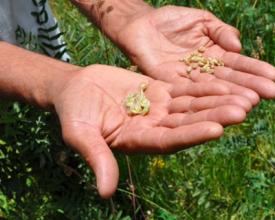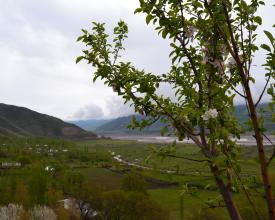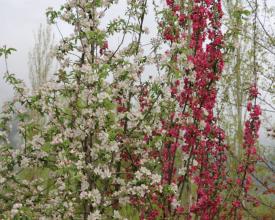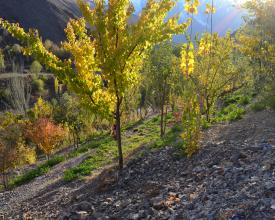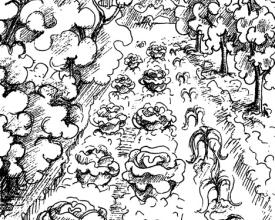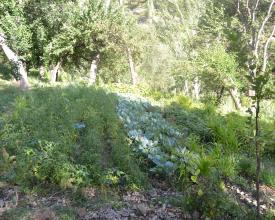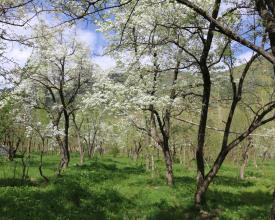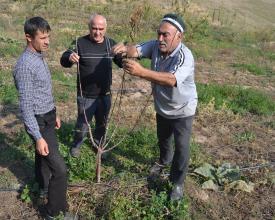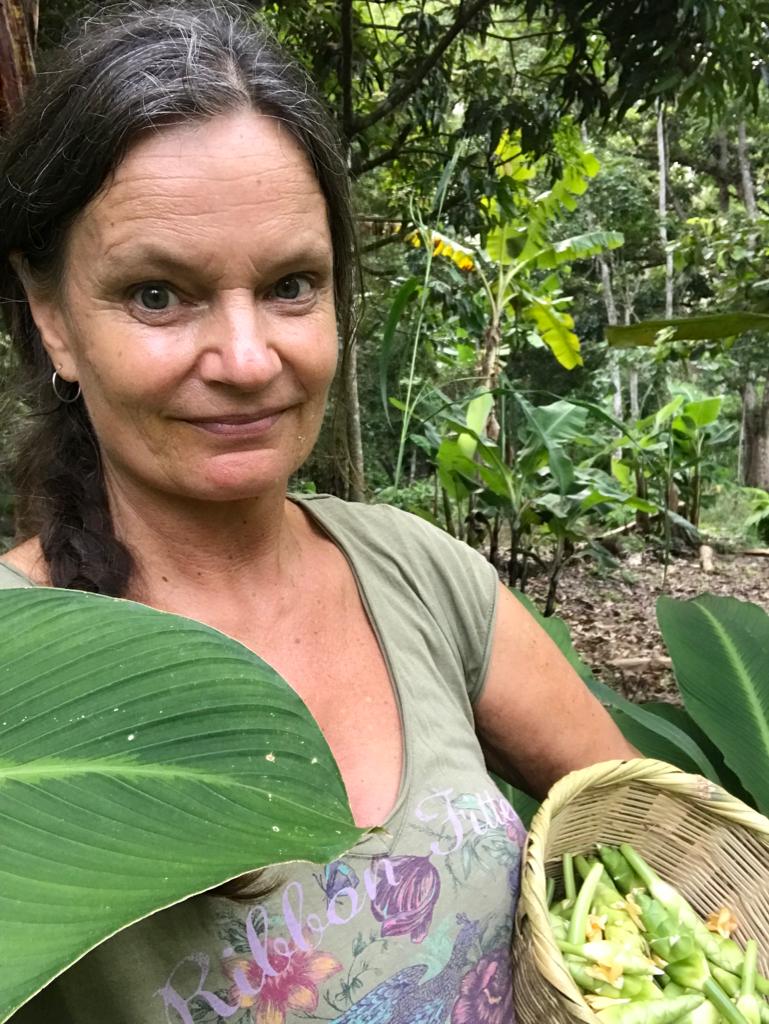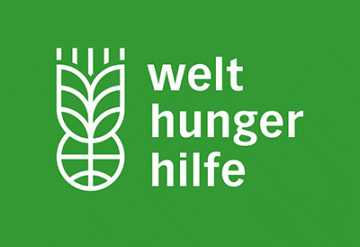
Resilient Orchards
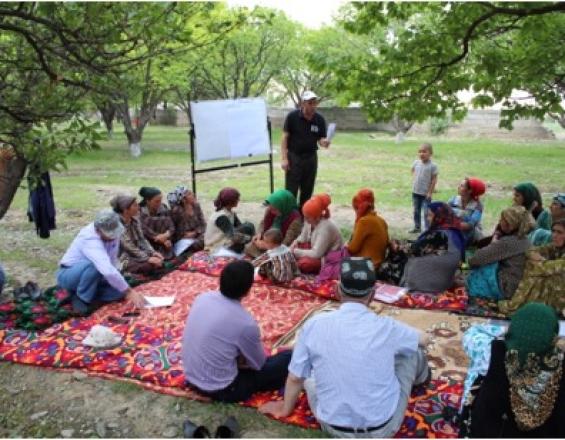
Orchards are very common in Tajikistan’s landscapes and a widely used practice of cultivating fruit trees. Even though a diversified orchard offers multiple benefits, for efficiency reasons, however, many orchards comprise a limited variety of species.
Diversified tree species reduce the risk of pest and diseases outbreaks and ensure a healthy soil structure with an adequate removal and input of nutrients. Furthermore, the different blooming times of tree species provide nectar for pollinators over a longer period of time and hence are beneficial for beekeeping.
When setting up a resilient orchard, it is recommended to conserve natural flora and fauna and to establish the orchard in such a way that disruption of the surrounding environment is kept to a minimum e.g. incorporating existing natural resources into the structure of the orchard.
The key to designing a resilient orchard is selecting fruit tree species and developing a long-term orchard management plan (10-15 years).
Contexte
Challenges addressed
Despite the significative positive impacts promoted by resilient orchards, concrete challenges can affect their progress.
Establishing an orchard necessitates specific knowledge of fruit tree species and their site requirements, pruning and grafting techniques as well as Integrated Pest Management.
The financial exposure required in the initial steps is relatively high, especially if an irrigation system is required, and concrete economic benefits appear only in the medium and long term.
Erosion and formation of gullies may be the risks connected with improper management of irrigation.
Emplacement
Traiter
Summary of the process
The building blocks in the context of resilient orchards are interlinked and interdependent. Therefore, only the combination of all the building blocks results in a better managed resilient orchard. Traditional, local varieties of fruit trees, which are normally better adapted to the local climatic conditions, are conserved. Fruit trees associated with vegetables and fodder plants offer pollen and nectar to pollinators and other beneficial insects over much of the vegetation period, especially if no synthetic pesticides are applied. If fruit trees are associated with fodder plants for the production of hay, fodder supply for animals is better and grazing in early spring can be reduced. Adequate pruning is interlinked with the productivity of associated crops and part of IPM.
Building Blocks
Local varieties or varieties grafted on local rootstocks
It is cheaper to establish a traditional or semi-intensive orchard with local varieties than an intensive one based on imported seedlings since locally produced plants are cheaper and fewer plants/ha (approximately 500-600 vs 2,600-3,125) are required.
Furthermore, a semi-intensive orchard system based on local varieties allows for better vegetable growing and fodder planting between the trees. This outweighs the disadvantage that orchards established with local varieties and grafted on local rootstocks enter production later than intensive ones (5-6 years vs 2-4 years).
Traditional varieties of fruit trees are normally better adapted to local climate conditions and are more resistant or tolerant to pests and diseases. That implies economic benefits as costs for applying pesticides are reduced considerably, production levels are stable, and less irrigation water is needed.
In addition, local varieties bear fruits much longer (30-50 years vs. 10-12 years). It is recommended to involve specialists and consult with local nurseries before beginning reproduction of fruit trees seedlings since grafting requires some experience. Local nurseries can establish collections of varieties for cutting scions and hand them over to interested fruit growers.
Enabling factors
When reminded about the benefits of the local varieties of fruit trees and bushes during the knowledge exchange within farmers' field school training sessions, farmers tend to show interest in diversifying their orchards with these. Local nurseries or plantations established from local varieties such as the “apple park” in the Rasht pilot district of the project can serve as evidence and visually motivate the farmers to diversify their orchards with local varieties or varieties grafted on local rootstocks.
Lesson learned
Promoting traditional varieties is challenging as these are often forgotten and thus hardly available. Local nurseries should be encouraged reproducing these varieties and farmers should be connected with them. In addition, farmers can be motivated to produce seedlings e.g. by establishing community–based small nurseries, concentrating on local varieties of fruit trees and bushes.
When farmers are planning to produce fruits from local varieties not only for own consumption but also for sale, a market assessment should be conducted.
Crop Association
Vegetables or fodder crops can be planted between rows of fruit trees facilitating income from the orchard from the very beginning when fruit trees have not yet entered production. Associating fruit trees with vegetables or fodder crops is especially important in Tajikistan as farmer families have only little irrigated land and thus have to use it intensively. Vegetables can be used for subsistence or sold at market, whilst fodder crops as alfalfa and sainfoin can be planted for producing hay. Other advantages of cultivating fodder plants are that these create habitats and feed pollinators and beneficial insects. Most of the species flower after fruit trees have already blossomed, thereby extending the fodder supply for pollinators and improving conditions for beekeeping. Moreover, fodder plants protect the soil from erosion.
Enabling factors
The project trains farmers within the farmers' field schools on orchard management, including correct tree formation for leaving enough space for associated cultures. Fruit trees should be formed with longitudinal crowns, consisting of stem prolongation and two skeleton branches aligned along the row of trees, which allows for the cultivation of vegetable and fodder plants in between.
Lesson learned
Although associating vegetables or fodder crops between the rows within orchards is not new for most of the farmers, the technique can only be implemented successfully depending on several factors, including composition and design of the orchard, such as distances between the trees and the rows, correct pruning of trees, selection of species for associated crops and availability of irrigation water and infrastructure. Commonly, fruit trees are cultivated too dense which reduces fruit production per tree and makes the plantation for associated crops impossible due to the lack of sunlight reaching through the branches. If advanced irrigation systems are available, it has to be considered that trees preferably should be watered by drip irrigation and fodder plants by sprinkler irrigation which requires installing two different systems.
Integrated pest management (IPM)
The main aim of IPM is to reduce the infestation of any pest below the threshold of damage. Purchasing chemical pesticides is often too expensive for subsistence farmers. Nevertheless, some form of pest control is still vital, since a serious infestation can lead to a total loss of harvest. In this regard, the project promotes applying IPM, which requires permanent monitoring of the fields’ phytosanitary status, so that adequate measures are taken timely. For ensuring a resilient orchard in the first place, phytosanitary measures and biological pest control should be applied. Phytosanitary measures imply using certified seedlings, free from pests and diseases. Adequate pruning is important, for removing branches infested by die-back, and for prevention of diseases like mildew, as the leaves dry soon after rainfall or dew. During a pest outbreak, homemade insecticides can be prepared by mixing spices (chilli, garlic, onion, etc.) or toxic plants (walnut, tobacco, etc.) with soap, alcohol or oil. They can be applied for controlling insects, like aphids, thrips, and mites. Another measure for controlling pests consists of providing sources of fodder and hideouts for their natural enemies.
Enabling factors
Pests and diseases directly impair the production and quality of fruit, which is a strong motivation for farmers to engage in pest control. Additionally, it becomes increasingly accepted among farmers that the use of synthetic pesticides is harmful to the environment. Therefore, the holistic approach of managing pests and diseases promoted within training sessions in the farmers' field schools was generally welcomed. Furthermore, the homemade insecticides are cheap and most of them are not harmful to the environment and the users.
Lesson learned
A few aspects could already be identified over the course of the project:
- Many farmers tend not to take proactive measures towards pest management due to limited technical knowledge/information available in this regard.
- Synthetic pesticides have a more resounding effect than homemade ones, which need to be applied repeatedly. Therefore, many farmers still prefer synthetic pesticides and it is challenging to convince them of the benefits of homemade ones.
Prunining and formation of fruit trees
In order to develop good quality fruit yields and to enable the association of fruit growing with vegetable or fodder production in the long-run, optimal fruit tree formation is vital. From the beginning of their lifecycle, fruit trees should be formed by pruning, binding up and spreading branches. For building up stable and light-flooded trees, skeleton and fruit branches should be clearly differentiated. In the later stages of its lifecycle, maintenance pruning is used to remove superfluous fruit branches, shoots and deadwood. This allows sunlight to penetrate the inward of the tree, offering the conditions to produce bigger fruits that taste better. When fruit trees become very high and quality of fruit decline, they can be rejuvenated through rehabilitation pruning. Adequate pruning also can prevent pests and diseases, as is ensures that the trees are not too dense, and wind can pass through. The surface of leaves will consequently dry quickly after rain or dewfall and consequently spores of diseases as powdery mildew will not germinate.
Enabling factors
An exemplary orchard with adequately pruned trees which produce high-quality fruit serves as motivation for farmers to replicate this seemingly easy, yet very important technique. Small incentives, such as pruning scissors and saws distributed during the practical parts of the training sessions have also proved to be very motivating.
Lesson learned
Most farmers in Tajikistan lack knowledge about adequate pruning, which is why quantity and quality of fruit production as well as associated crops lags its potential. The experience shows that a single round of training might not be enough for the farmers to adopt adequate pruning techniques.
Impacts
Resilient orchards not only address environmental challenges but also economic and social dimensions.
The diversified production of fruit and nuts contributes to an improved vitamin and nutrition intake through a balanced diet. In addition, processed fruites in form of dried fruits, jam, juice or compote generate additional income, especially if stored and sold during the winter months.
Fruit trees associated with vegetables, herbs and fodder plants offer pollinators and other beneficial insects pollen and nectar during most of the vegetation period.
It also contributes to the reduction of grazing in early springs and better fodder supply for animals thanks to the association of fruit trees with fodder plants for production of hay.
Since resilient orchards use as few additional inputs as possible, avoiding the alteration of the ecosystem, natural stone walls and natural/living fences offer habitat and hiding places for fauna.
Beneficiaries
The beneficiaries of the approach are farmers interested in trying out
-diversifying their orchards with various local tree and bush species as well as
-in growing associated crops and vegetables.
Sustainable Development Goals
Story
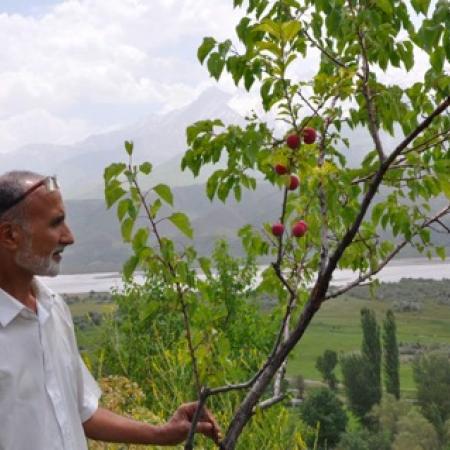
Mirzosho Akobirov started his journey into cultivating and preserving old local varieties of fruit trees 25 years ago. His disposition for fruit trees seemingly was nurtured from a young age. Already his grandfather was known in the neighboring valley Mazor for his expertise with fruit trees and his passion for poetry and music. As a young man, his grandfather fled from a mudflow that wiped out his whole family in 1949 in Mazor. Suddenly uprooted he came to Jafr where he started his life anew. What he brought along was his knowledge about trees.
When biodiversity started to become known as a concept in Tajikistan five years ago, he was already practicing himself for a long time by building upon his grandfather’s and father’s knowledge. Since 2017, he contributes with his knowledge to the international project “BIodiversity and ecosystem services in agrarian landscapes” implemented by the Deutsche Gesellschaft für Internationale Zusammenarbeit (GIZ) GmbH in cooperation with the Deutsche Welthungerhilfe, and commissioned by the International Climate Initiative (IKI) of the Federal Ministry for the Environment, Nature Conservation, and Nuclear Safety (BMU).
The project is implemented in two regions in Tajikistan and in three countries in the world, Kenya, India, and Tajikistan. Mirzosho takes an active role in promoting biodiversity by implementing the Farmer Field Schools in the watersheds of Jafr and Mazor in Rasht valley. Practical lessons and discussions in the Farmer Field Schools are complemented by visits to Zerafshan valley. These meetings offer the possibility to the farmers to exchange their knowledge and experiences with the approaches promoted in order to foster biodiversity and ecosystem services in Tajikistan.
Mirzosho enthusiastically explains the variety of plants and their seeds as well as about the different challenges and techniques which can be applied to their benefit. After long years of taking care of fruit trees, he seems to have incorporated their essential lesson: Knowledge has to be shared as a fruit tree shares its seeds freely.

